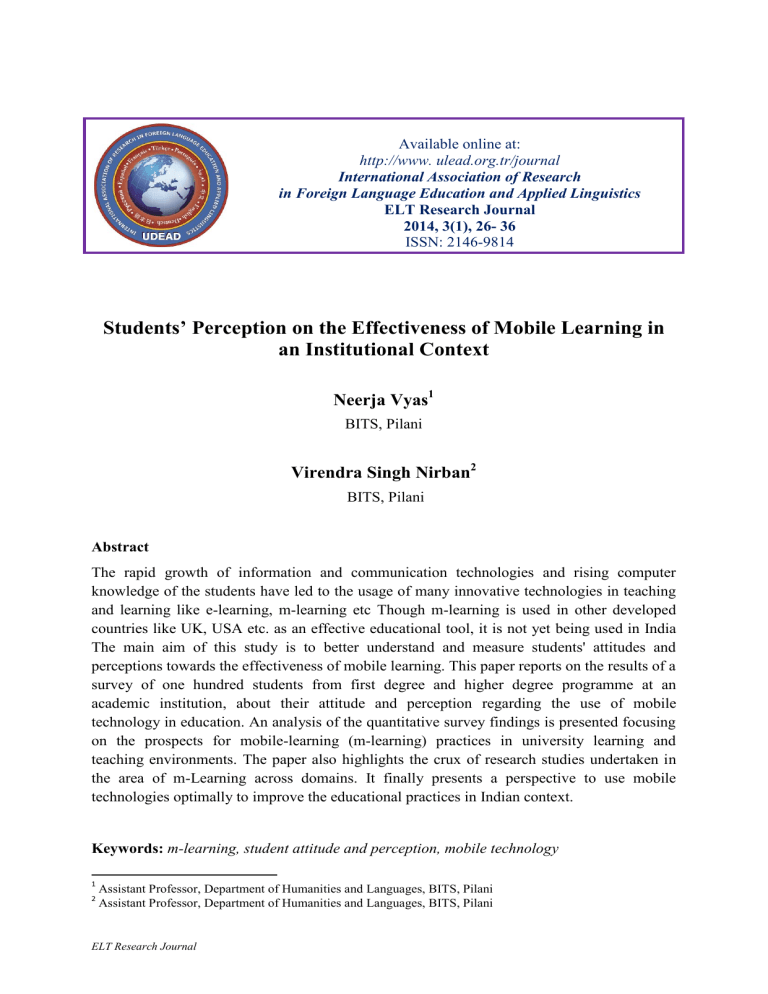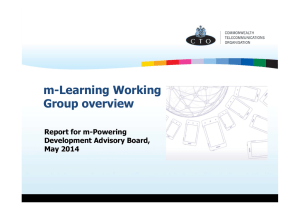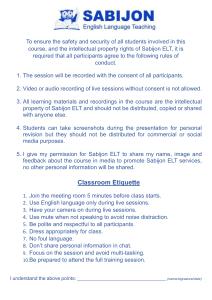
Available online at: http://www. ulead.org.tr/journal International Association of Research in Foreign Language Education and Applied Linguistics ELT Research Journal 2014, 3(1), 26- 36 ISSN: 2146-9814 Students’ Perception on the Effectiveness of Mobile Learning in an Institutional Context Neerja Vyas1 BITS, Pilani Virendra Singh Nirban2 BITS, Pilani Abstract The rapid growth of information and communication technologies and rising computer knowledge of the students have led to the usage of many innovative technologies in teaching and learning like e-learning, m-learning etc Though m-learning is used in other developed countries like UK, USA etc. as an effective educational tool, it is not yet being used in India The main aim of this study is to better understand and measure students' attitudes and perceptions towards the effectiveness of mobile learning. This paper reports on the results of a survey of one hundred students from first degree and higher degree programme at an academic institution, about their attitude and perception regarding the use of mobile technology in education. An analysis of the quantitative survey findings is presented focusing on the prospects for mobile-learning (m-learning) practices in university learning and teaching environments. The paper also highlights the crux of research studies undertaken in the area of m-Learning across domains. It finally presents a perspective to use mobile technologies optimally to improve the educational practices in Indian context. Keywords: m-learning, student attitude and perception, mobile technology 1 2 Assistant Professor, Department of Humanities and Languages, BITS, Pilani Assistant Professor, Department of Humanities and Languages, BITS, Pilani ELT Research Journal Students’ perception on the effectiveness of mobile learning in an institutional context 27 Introduction Over the last few decades information and communication technologies have improved greatly and the use of computers has become more widespread. The evolution of handheld portable devices and wireless technologies has resulted in radical changes in the social and economic lifestyles of modern people. Today, many technological devices are produced in portable form and people have become accustomed to them. These devices are reshaping user behaviour in daily lives in different ways. An equally significant intrusion of computers and internet has been seen in the education area also. As a result, educators have started looking at ways to use this technology to enhance the learning experience. After the initial impact of computers and their applications in education, the introduction of e-learning and m-learning epitomised the constant transformations occurring in education. But the development of digital technologies has so far been limited to social communication and a few people have regarded the potential of mobile learning as an effective tool for pedagogical activity in higher education. Recent innovations in program applications and social softwares using Web 2.0 technologies (e.g., blogs, wikis, Twitter, YouTube) or social networking sites (such as Facebook and MySpace) have made mobile devices more dynamic and pervasive and also promise more educational potential. Mobile learning refers to the use of mobile or wireless devices for the purpose of learning while on the move. Cell phones, smartphones, palmtops, and handheld computers, tablet PCs, laptops, and personal media players can be the typical examples of the devices used for mobile learning. It is important to understand the dimensions of computer and allied technologies based education to adequately appraise their potential to enhance learning experience. Computer Based Education (CBE) was one of the initial stages, leading to online education and elearning in the mid-1990s. E-learning offered new ways for students to access many resources. This was a major breakthrough in education leading to better management of both in-house tertiary education and distance education. According to Liu & Hwang (2010), modern technology-aided learning is found in three stages ranging from conventional e-learning to m-learning to context-aware u-learning. Conventional e-learning refers to using computer and the Internet for learning. This is where computer plays a vital role in modern education and pedagogy. M-learning (or mobile earning) is realized with mobile devices and wireless communication. Context-aware ulearning (or ubiquitous-learning) requires mobile devices equipped with sensor technology and wireless communication (Fuxin Andrew Yu, 2012) Context-aware u-learning could be classified under m-learning because as more smart phones enable sensor technology, mlearning will become indistinguishable from context-aware u-learning. According to El-Hussein & Cronje (2010), the definition for m-learning contains three key components– mobility of technology, mobility of learners, and mobility of learning processes. © International Association of Research in Foreign Language Education and Applied Linguistics - All rights reserved. Vyas, N. & Nirban, V.S. / ELT Research Journal 2014, 3(1), 26-36 28 1. Mobility of technology- refers to the mobile nature of installed hardware and software that enable wireless Internet connection. 2. Mobility of learners- means learners are no longer physically attached to one or several learning sites, and they can be mobile and learn at the same time as long as the mobile devices are around. 3. Finally, mobility of learning is the result of mobility of both the technology and learners. If e-learning took learning away from the classroom or campus, then m-learning is taking learning away from a fixed point. Where e-learning is an alternative to classroom learning (actually e-Learning should/can be complementary to classroom learning) - m-learning is a complementary activity to both e-learning and traditional learning. M-learning respects that a user would like to interact with educational resources whilst away from their normal place of learning – classroom or computer. Literature Review Mobile technology has seen a surge only in last five to six years. In its evolution it has become dynamic and robust. Therefore, historically, mobile learning by itself is a very immature discipline. Academicians, researchers and scholars are yet to define a set of attributes which uniquely characterizes mobile learning. Moreover, the fact that it involves disciplines like Software engineering, Internet technology and ubiquitous presence makes it more difficult to define it. In his preliminary attempt to address the issues in defining mobile learning, John Traxler (2005) opines that: ―Mobile learning is new. It is currently difficult to define, conceptualise and discuss. It could perhaps be a wholly new and distinct educational format, needing to set its own standards and expectations, or it could be a variety of e-learning, inheriting the discourse and limitations of this slightly more mature discipline.‖ In a quantitative survey of students at King Saud University, Saudi Arabia, Fahad(2009)studied the attitude and perception of the students about the use of mobile technology in education. He attempted to determine how this technology can be optimally used to improve student retention. The variables taken into consideration included gender, course of study and attitudes towards new technology. The analysis of student perception on m-learning points to the fact that mobile learning is widely embraced by them. The majority of student supported the notion that the wireless networks increase the flexibility of access to resources in learning and that they could work independently of variable resources like lab or library PCs. Cellphones have the potential to improve education for the millions of underprivileged users in the developing world. In a study conducted by Tewari, Canny and others(2010) it was argued that cellphones are a perfect vehicle for making educational opportunities accessible to rural children in places and times that are more convenient than formal ELT Research Journal Students’ perception on the effectiveness of mobile learning in an institutional context 29 schooling. They carried out participant observations to identify the opportunities in their everyday lives for mobile learning. A 26-week study was conducted to investigate the extent to which rural children will voluntarily make use of cellphones, to access educational content, when they were not supervised. The results show a reasonable level of academic learning and motivation. They not only showed that some degree of academic learning occurred, but also exhibited that the extent of such learning could potentially be increased if barriers owing to limited electricity and gender attitudes could be overcome. DivyaVishwanathan and Jan Blom (2010) in the paper New Metaphors from Old Practices—Mobile Learning to Revitalize Education in Developing Regions of the World, present initial work, which has been primarily done in the domain of mobile learning solutions for economically challenged Indian school children. It provides an overview of the initial stages of the concept design process that has so far consisted of field visits to Indian schools as well as an open-ended exploratory workshop in Bangalore. While the research has only covered India, it seems the design framework will eventually be general enough so as to lead to a mobile learning solution that is applicable across the developing regions of the world. Two levels of findings emerge from the field visits and expert interviews. General insights were extracted pertaining to challenges associated with the educational context. The expert interviews showed that the government education system suffers from a severe lack of resources. An opportunity emerges for educational technology, namely one related to revitalizing the learning processes and increasing the motivation of not only learners but also teachers. Fuxin (2012)in his paper explores the evolution of the smart phone into a potentially powerful learning tool by providing a literature review on smart phone‘s use in higher education, and lays a foundation for future research that examines the digital gap between teacher and student related toknowledge and use of smart phone in an existing university Methodology In order to study the attitudes of students on the effectiveness of mobile learning, a questionnaire was developed with 10 items. The Study was conducted in a reputed private educational institute. A random sample of 150 undergraduate and post-graduate students, i.e. first degree and higher degree, were given the questionnaire.100 completely filled responses were received and the datacollected was processed and statistically analyzed through conventional excel sheet data feeding.The questionnaire consisted of ‗yes-no‘ questions, ‗preference based questions‘ and ‗open ended questions‘. The graphs and charts were made to reflect trends and change points. Statistical description approach was used to explain the numbers compiled from questionnaire responses. Qualitative remarks collected via open ended question were used to substantiate the analysis. The study is a pilot study that can be used for a major research project in the area ofm- learning in Indian context. © International Association of Research in Foreign Language Education and Applied Linguistics - All rights reserved. Vyas, N. & Nirban, V.S. / ELT Research Journal 2014, 3(1), 26-36 30 Results and Discussion Responses to the first question regarding the definition of mobile learning, show a good level of awareness among students as 59% of the respondents said that it is learning using portable devices. Whereas 22% could precisely point that it is learning possibly using mobile devices while the learner is on move. Figure 1 further shows that out of the 22 correct response 14 were from higher degree and 8 from the first degree. (In the following figure, A=learning using internet enabled computers, B= learning using portable devices, C= learning possible while the learner is moving, D= learning possible while the learner is moving using portable devices, HD= higher degree, FD= first degree) 70 59 60 50 40 36 30 23 22 20 14 11 8 10 8 3 8 6 2 0 A A_HD A_FD B B_HD B_FD C C_HD C_FD D D_HD D_FD Figure 1.Awareness about m-learning. In response to the other question on the use of different mobile devices like laptops, smart phones (SP) and tablets/ I-pads (I-PD/TAB) , results show that, 84% ( out of which HD= 38% and FD= 46%) of the total respondents use laptops, 64% use smart phones and only 16% use tablets or I-pads. Use of laptops being the highest can be attributed to the fact that students are still not very comfortable with handling of the advanced devices like smart phones or tablets especially for educational purposes and prefer laptops which are closer to desktop computers. The other reason can be the high cost of such devices. Whereas Figure 2 clearly indicates this preference of laptops over smartphones, figure 3, shows that most of these devices used by the students are equipped internet facilities. This can be substantiatedby the responses where 81% respondents have internet enabled mobile devices and only 19% do not have such facility. ELT Research Journal Students’ perception on the effectiveness of mobile learning in an institutional context Figure 2. Mobile devices used 31 Figure 3. Availability of internet facility Figure 4.shows that 97% of the total respondents use their mobile phones for calling purpose, 79% for texting, 75% use it as a means of entertainment, 65% for educational material and only 19% of them use it for online lectures. This suggests that though mobile devices are quite popular among students and mobile technologies are rapidly becoming more ubiquitous and, arguably, more accessible to a large number of learners but they still cling to conventional methods of learning as they may find them more convenient being already familiar to them. Another reason for this can be that there is no considerable effort by the teachers who can lead the students in this direction by taking an initiative as they still use traditional ways of teachimg. 19 online lectures 65 educational material 75 means of entertainment 79 texting 97 calling 0 20 40 60 80 100 Figure 4.Different uses of the mobile phone Mobile learning can also provide good support to micro-learning, a new and effective way of learning (Habitzel, Mark, Stehno&Prock, 2006). It has been observed by Habitzel and his colleagues (2006) that people can learn more effectively if "information" is broken down © International Association of Research in Foreign Language Education and Applied Linguistics - All rights reserved. Vyas, N. & Nirban, V.S. / ELT Research Journal 2014, 3(1), 26-36 32 into smaller, more easy-to-comprehend units. Therefore it is suggested here, that mobile learning is an ideal medium simply because it supports this "new way" of learning via the use of SMS, pre-recorded MP3 fits, and so forth. Fig. 5 shows the response to the question whether it is possible to use mobile/portable devices for mainstream education. 81% (HD=38% and FD=43%) of the students feel mobile learning can be used for mainstream education whereas 19% (HD=8% and FD=11%) of them hold the opposite view and don‘t find it competent enough to be used for this purpose. 100 81 80 60 43 38 40 19 8 20 11 0 YES YES_HD YES_FD NO NO_HD NO_FD Figure 5. Mobile learning for mainstream education 31 47 1 st_pa 2 st_sa 33 3 st_sa 45 52 4 st_pa 5 st_sa Figure 6. Student preferences This response can be further compared to the responses of the preference based question (figure 6) in which 39% students strongly agree that Mobile learning can be an effective method of learning as it can give immediate support, 47% partially agree (in fig. 6, 1 st_pa) to this whereas only 4% do not consider it as an effective method. The reasons for this can be traced in the response to the statement of the same question where52% (in fig. 6, 3 st_sa) of the total students strongly agree to the factthat Mobile learning is a more flexible method of learning as it can be done anytime and anywhere. 31% of the total respondents strongly agree that (in fig. 6, 5 st_sa) Mobile learning is a quicker method of getting feed ELT Research Journal Students’ perception on the effectiveness of mobile learning in an institutional context 33 back in learning and 45% strongly agree (in fig. 6, 2 st_sa) that Mobile learning will bring new opportunities of learning. 33% partially agree (in fig. 6, 4 st_pa) to the statement that mobile learning will improve the communication between student and teacher. Analysing the collected data we can say that the majority of respondents in this study confirmed the importance of mobile devices for its flexible availability and improving the communication between students and teacher. Figure 7 shows what kind of educational content do the students prefer and we can see that that highest number of respondents prefer powerpoint presentations (PPT) as 69% (HD=35% and FD=34%) of them responded in favour of it, 66% (HD=24% and FD=42%) prefer videos, 39% (HD=17% and FD=22%) prefer lecture notes (LEC. NTS) and 27% (HD=14 and FD=13) of them prefer audio lectures (AD. LEC). 80 70 69 66 60 50 40 30 20 42 35 34 27 39 24 14 13 17 22 10 0 Figure 7. Preference for educational content As a large number of students prefer PPTs and videos over lecture notes and audio lectures we can say that the trend is changing and the students are now more keen to use educational material which is not so conventional and with which we can hope that the trend in learning and teaching practices will also change, more drastically in coming years, in favour of mobile learning. When being asked if they are comfortable in handling, installation and configuration of educational software and applications on their mobile devices 88% (HD=42% and FD=46%) of them responded in favour of it and only 12% (HD=4% and FD=8%) said that they are not comfortable doing so. © International Association of Research in Foreign Language Education and Applied Linguistics - All rights reserved. Vyas, N. & Nirban, V.S. / ELT Research Journal 2014, 3(1), 26-36 34 100 88 80 60 46 42 40 20 12 4 8 NO_HD NO_FD 0 YES YES_HD YES_FD NO Figure 8.Comfort with the advanced software and application The results indicate that a large number of students are familiar with such software or applications that can be used for educational purposes. In response to the question about the educational mobile applications that the students are aware of or used, 91% of them say that have used the application dictionary (DCT.),56% of the total respondents have used the application blackboard (BB) and 9%are aware of it, 83% have used e-books (EB) and 64% of them have used atlas (AT.). The results show that a number of students are aware of and are using such applications but still some more advanced applications like blackboard and coursesmart (CS) are being used by very less number of students. The reason can be the lack of awareness as to what these applications can be effectively used for or lack of accessibility as such applications come in more advanced devices which are not possessed by many as they are quite expensive whereas the applications like e-book reader, dictionary or atlas are generally present in the mobile phones now a days. Figure 9 illustrates the above data 83 91 56 9 64 11 14 7 BB.A BB.U EB.A EB.U CS.A 10 5 CS.U AT.A AT.U DCT.A DCT.U Figure 9. Educational applications used ELT Research Journal Students’ perception on the effectiveness of mobile learning in an institutional context 35 When limiting factors regarding mobile learning were considered and the respondents were asked as to what can be the reasons because of which mobile learning cannot be used for learning, 16% of the respondents strongly feel that unavailability of appropriate mobile phones with a large no. of students is one of the major reasons but 21% of them strongly disagree to this. 20% strongly feel that poor networking infrastructure is a major hindrance and only 13% strongly agree to the fact that the expenses involved in mobile learning is a limiting factor. Conclusions India is successfully adapting to the digital age and evolution of ICT. Electronics and information technology is the fastest growing segment of industry in India, both in terms of production and exports. Within the education sector there have been outstanding initiatives to incorporate ICT into education at the state and national level. Mobile phone penetration is increasing rapidly in India as well as other developing countries. According to a survey, the elearning market in India has a growth rate of 17-18% annually. The results from the above study clearly indicate that majority of the respondents consider mobile technology as a significant medium for educational purposes and most of them are ready to accept the new means despite the limitations. With increased popular access to information and knowledge anywhere, anytime, the role of education, perhaps especially formal education, is challenged and the relationships between education, society, and technology are now more dynamic than ever. With mobile technology breaking social strata barriers in India and elsewhere, the time has come to embrace the new avenues in educational pedagogy in the form of m-learning and u-learning. References Canny, John., Deepti, C., Mathew, K., Anuj, K., Shroff, Geeta., &Tewari, Anuj. (2010). An Exploratory Study of Unsupervised Mobile Learning in Rural India. Retrieved from <http://www.cs.cmu.edu/~anujk1/CHI2010.pdf, 2010> El-Hussein, M. O. M., & Cronje, J. C. (2010). Defining Mobile Learning in the Higher Education Landscape. Educational Technology & society, 13(3), 12-21. Fahad N. Al-Fahad. (2009). Students' Attitudes and Perceptions towards the Effectiveness of Mobile Learning in King Saud University, Saudi Arabia. The Turkish Online Journal of Educational Technology, 8(2), 111-119. Garaj, Vanja. (2010). M-Learning in the Education of Multimedia Technologists and Designers at the University Level: A User Requirements Study. IEEE Transactions on Learning Technologies. 3(1), 24-32 Ally, Mohamed. (Ed.). (2009). Mobile Learning Transforming the Delivery of Education and Training. AU Press, Athabasca University. Sharmin, Kishoara. (2006). Mobile Learning as a Self Evaluation Tool, BRAC University. Traxler, John. (2005). Defining Mobile Learning. Proceedings of IADIS International Conference Mobile Learning. © International Association of Research in Foreign Language Education and Applied Linguistics - All rights reserved. Vyas, N. & Nirban, V.S. / ELT Research Journal 2014, 3(1), 26-36 36 Yu, (Andrew). Fuxin. (2012). Mobile/smart Phone Use in Higher Education. Proceedings of Southwest Decision Sciences Institute Conference. Viswanathan, Divya., & Blom, Jan. (2010). New Metaphors from Old Practices—Mobile Learning to Revitalize Education in Developing Regions of the World. IEEE Transactions on Learning Technologies, 3(1), 18-23 ELT Research Journal




